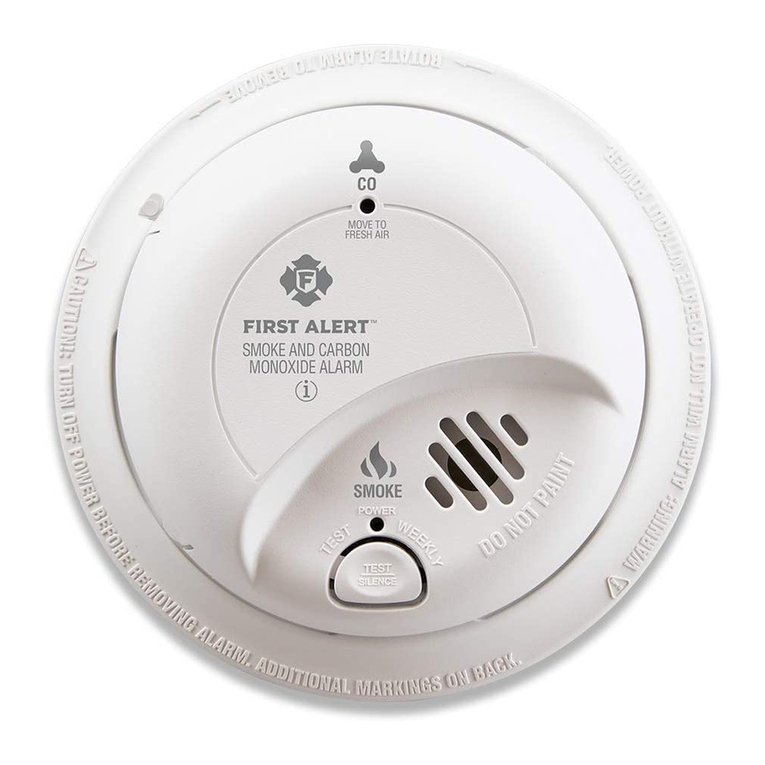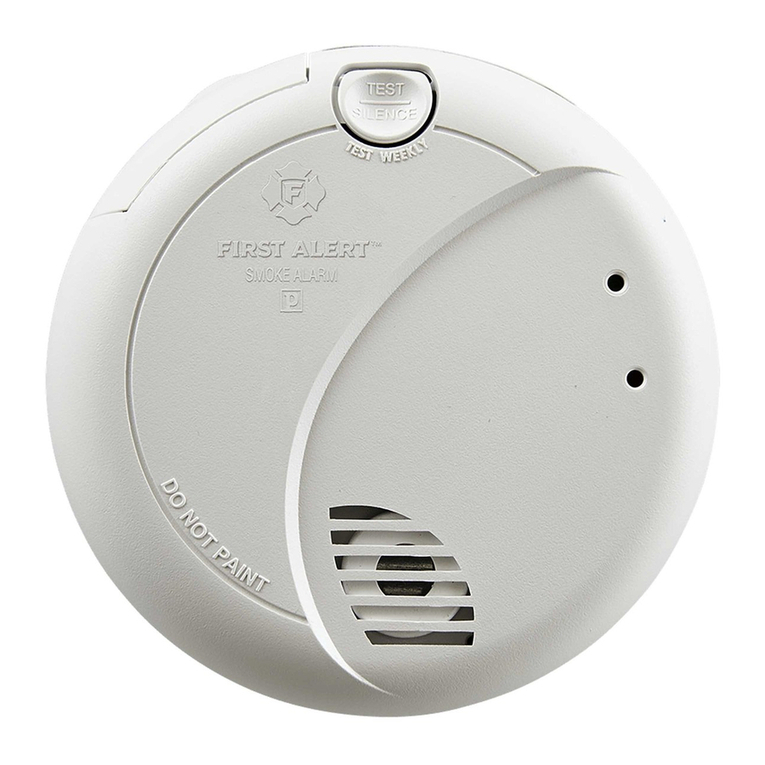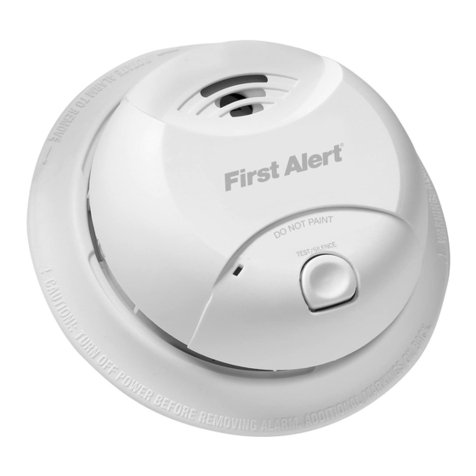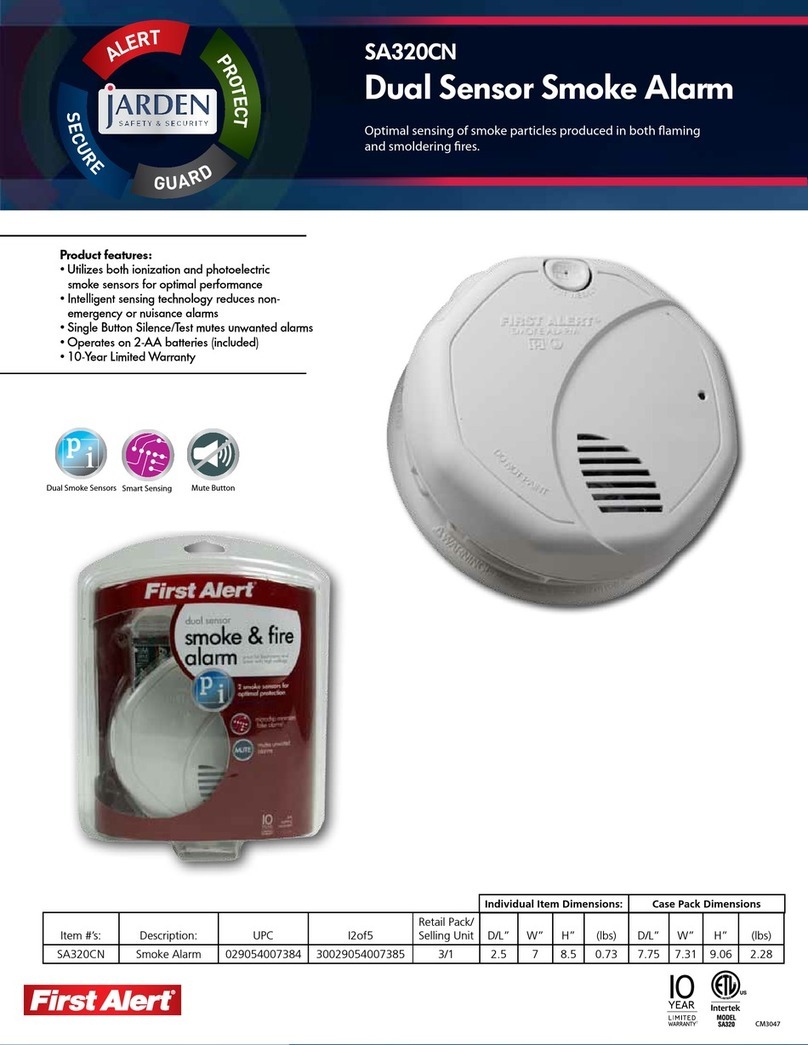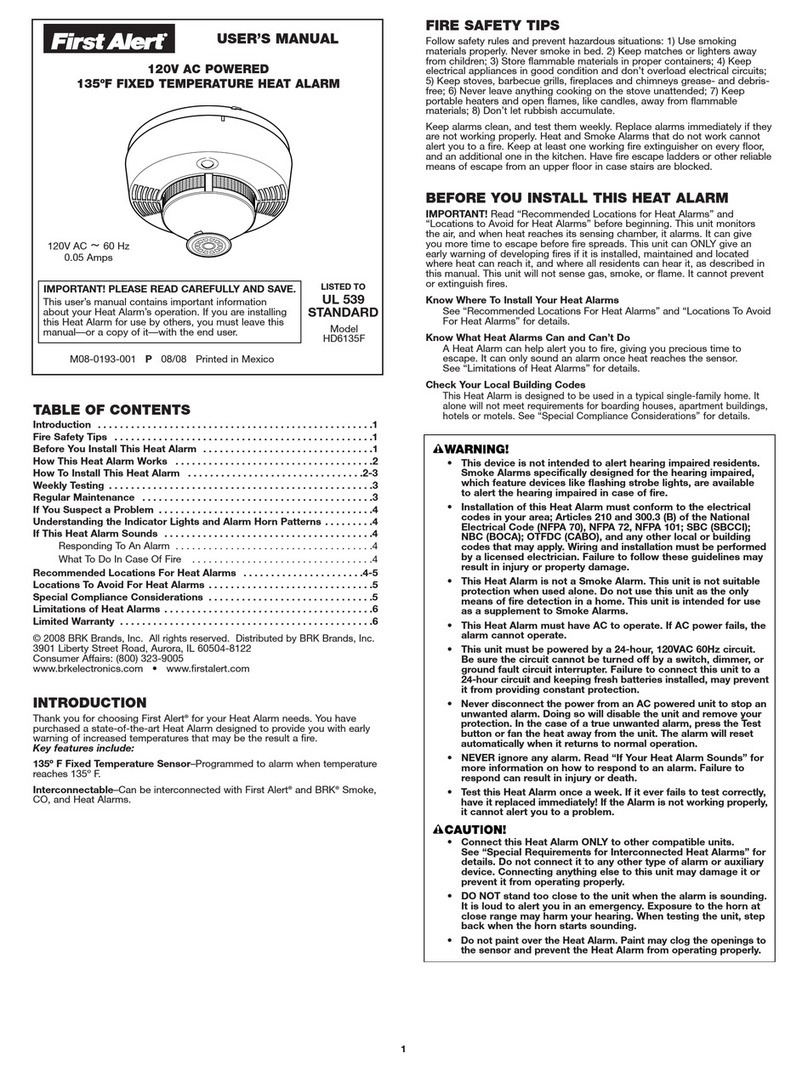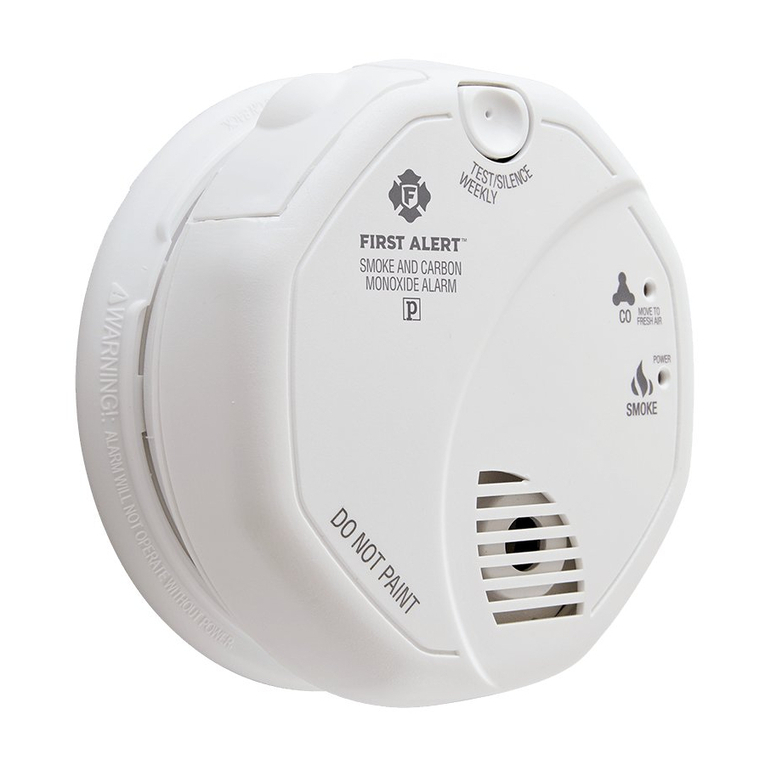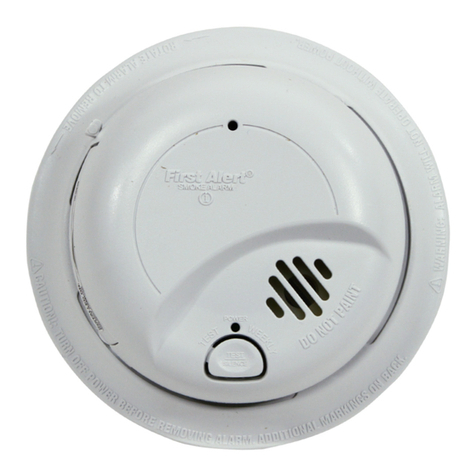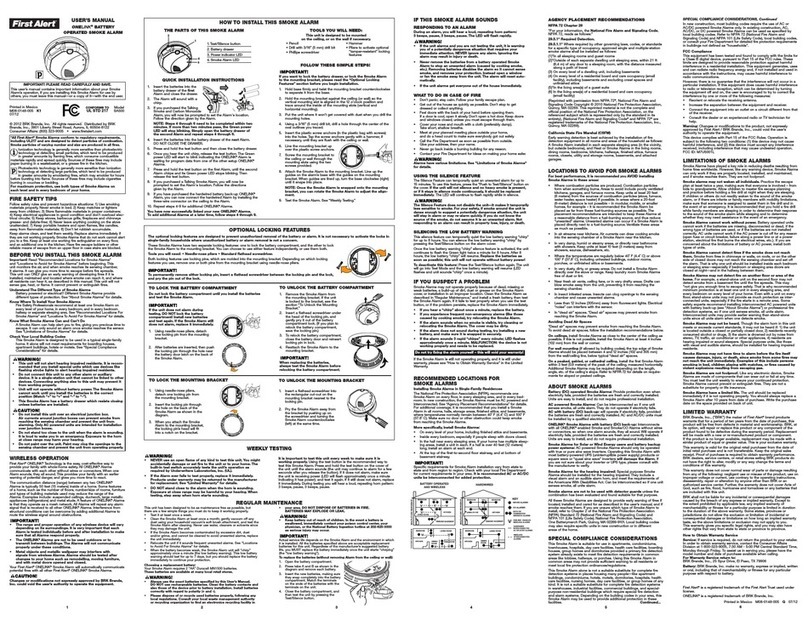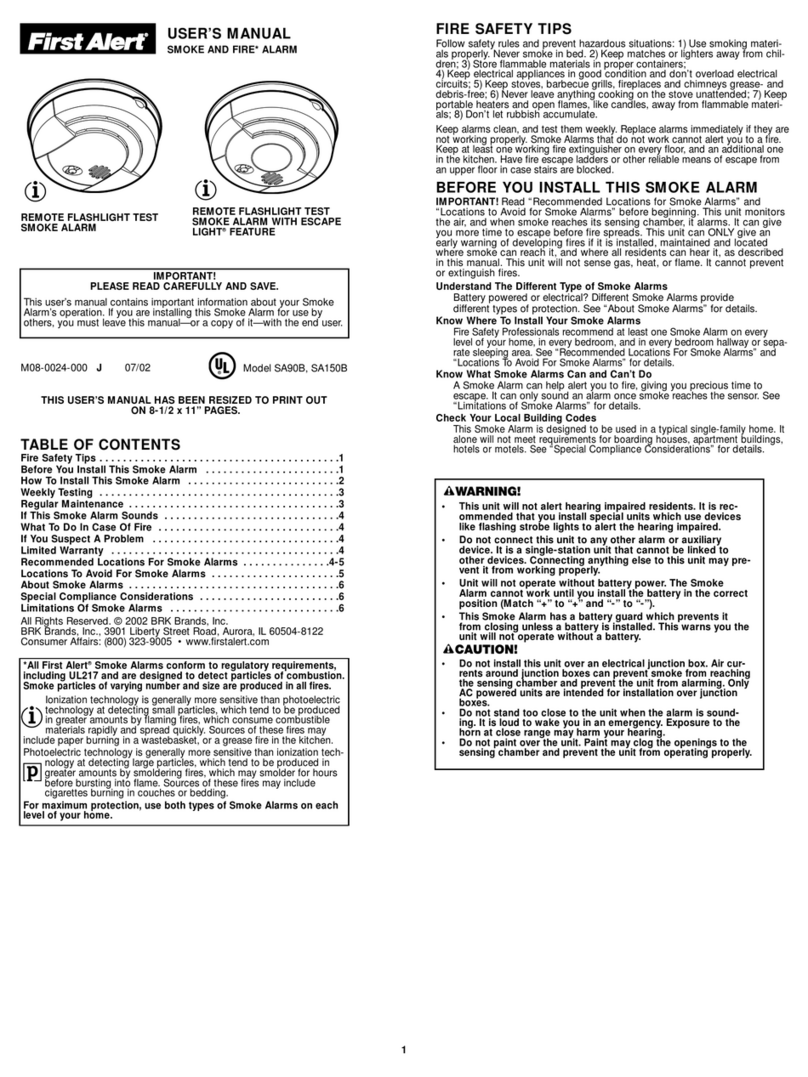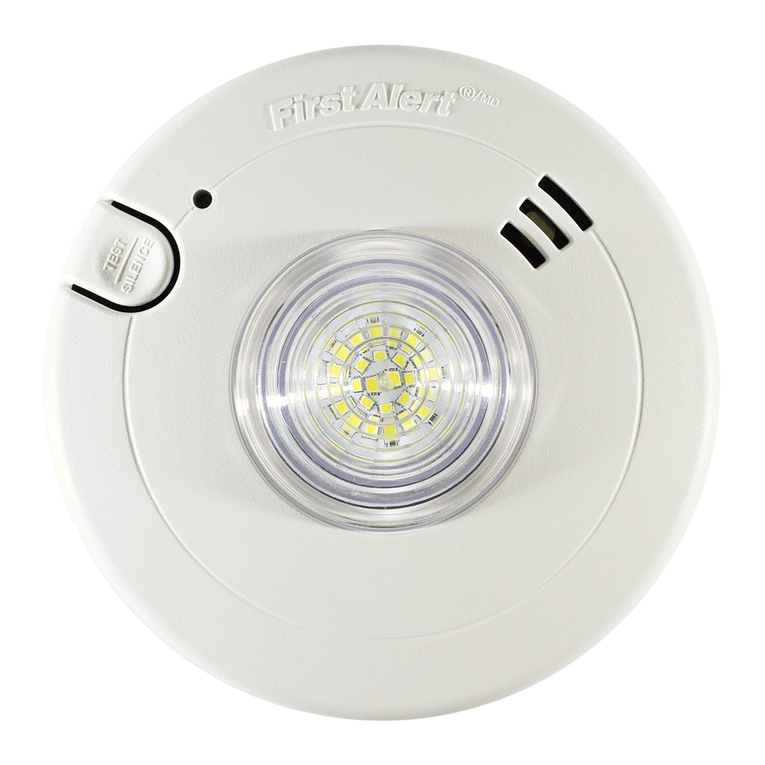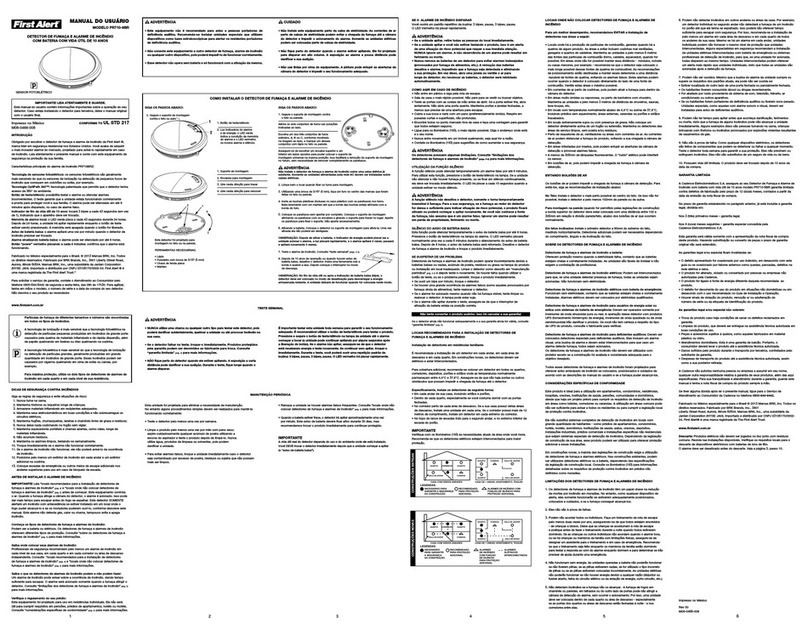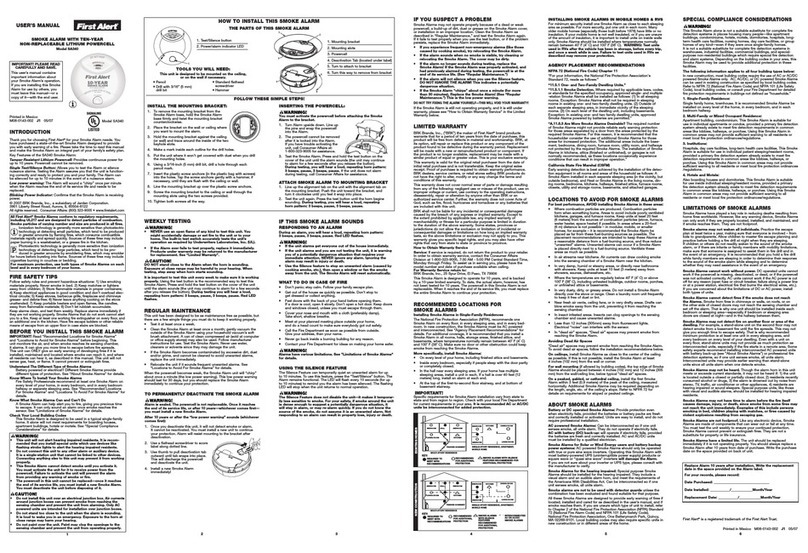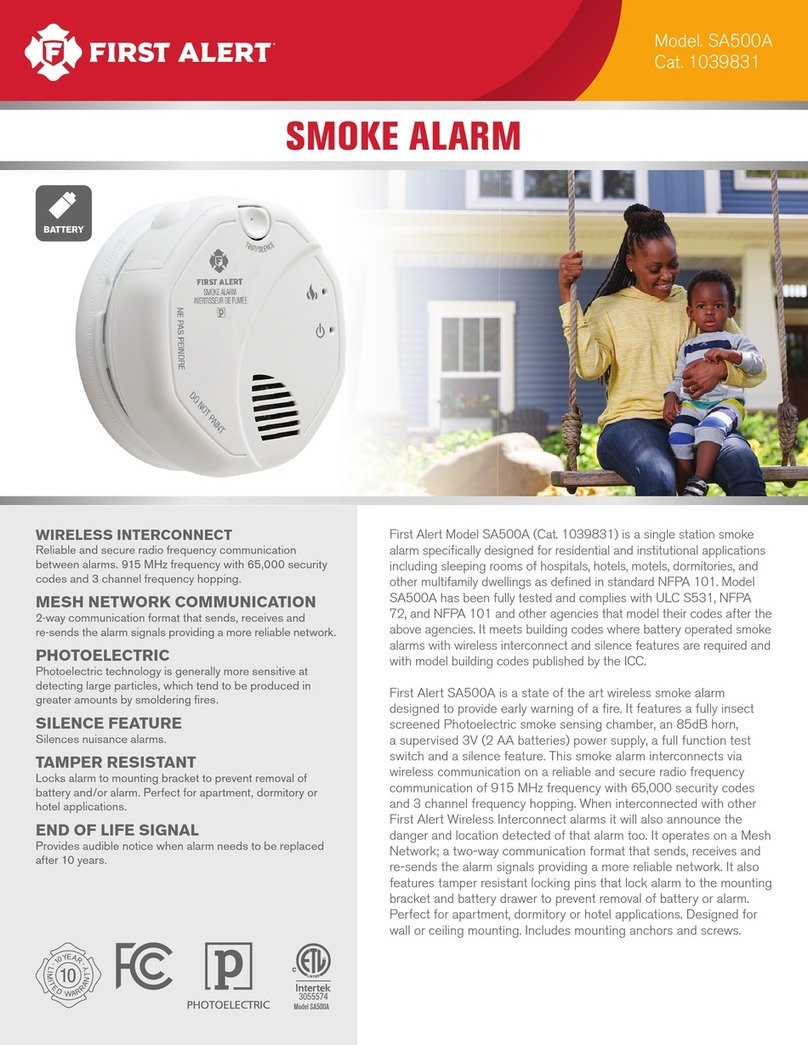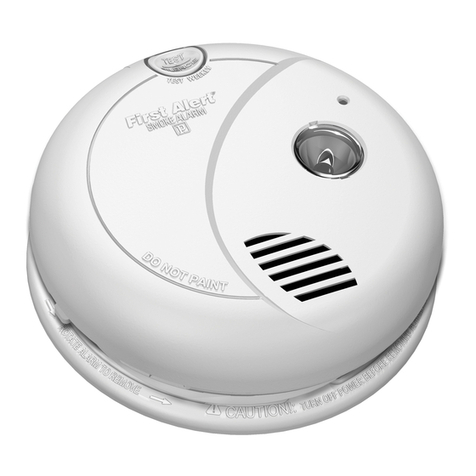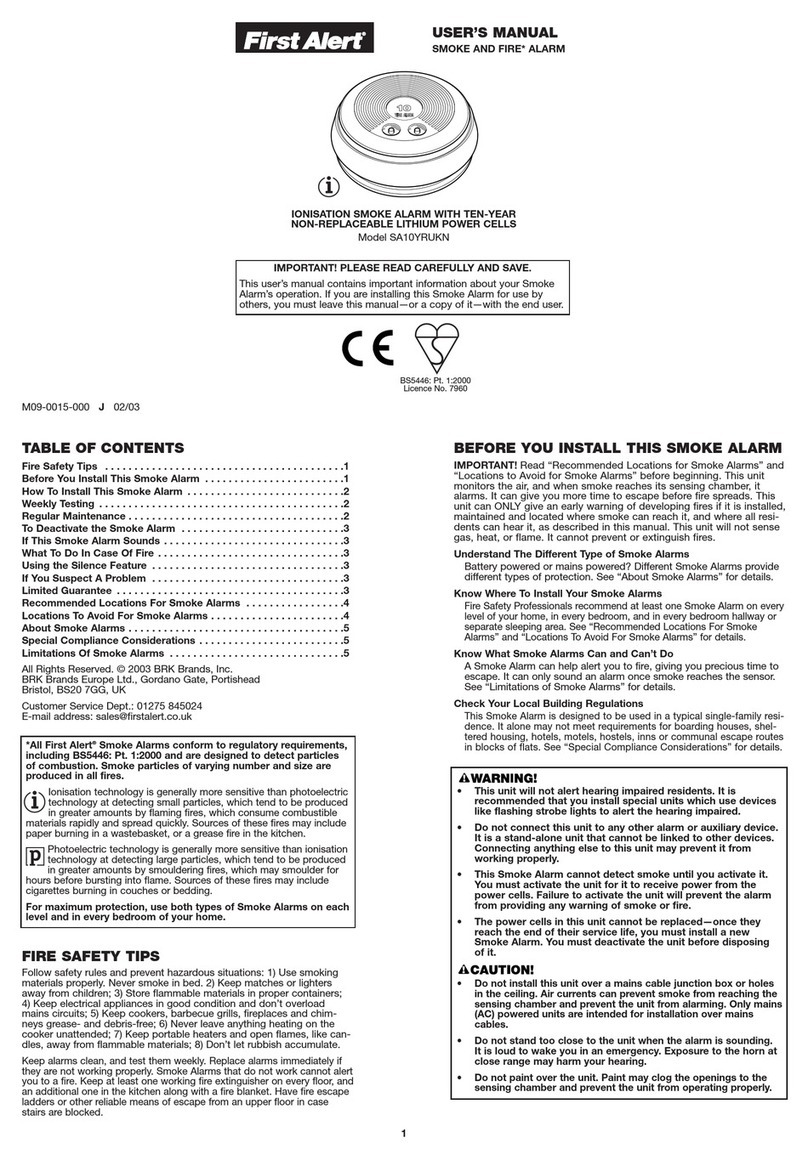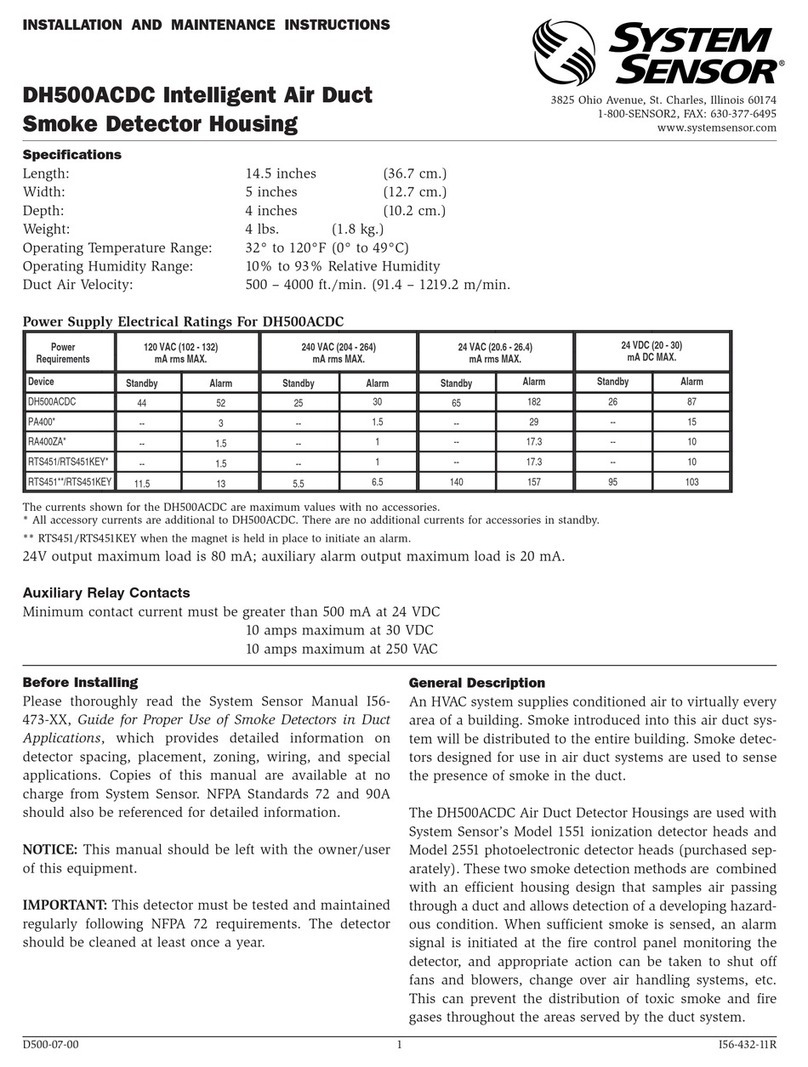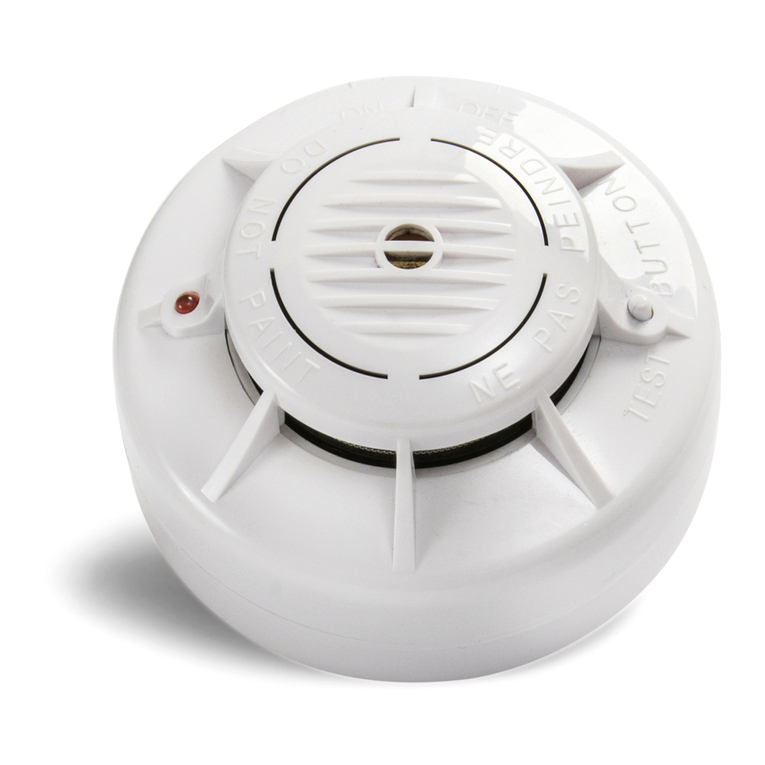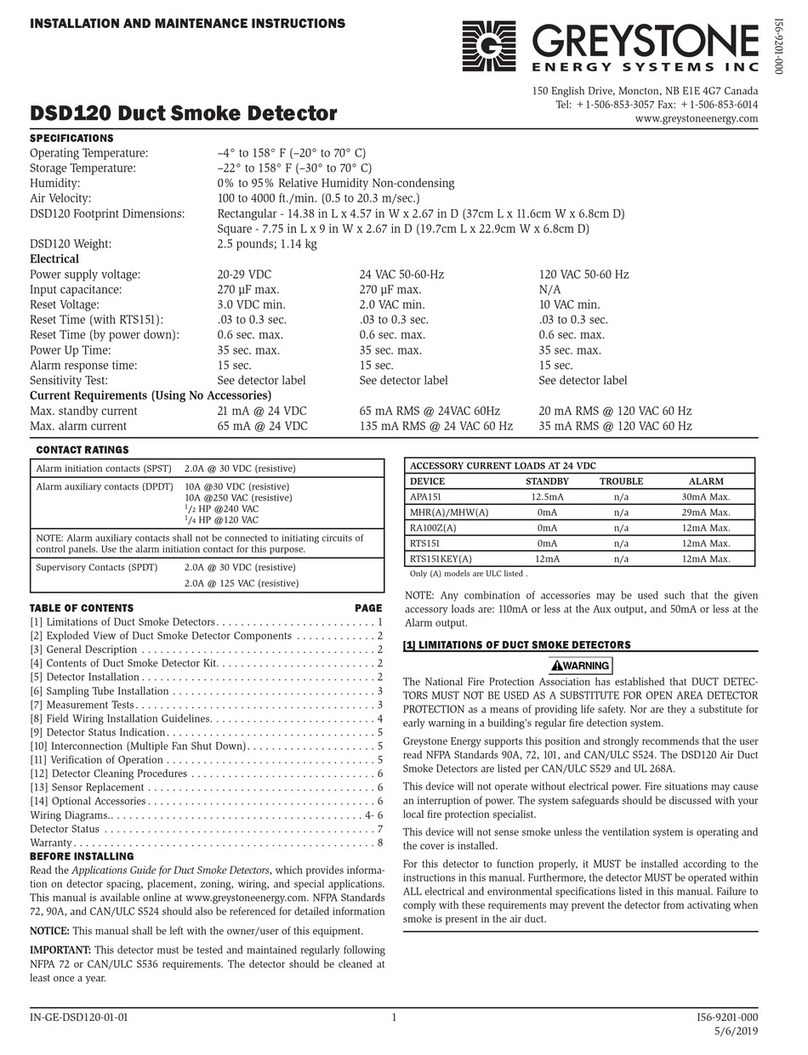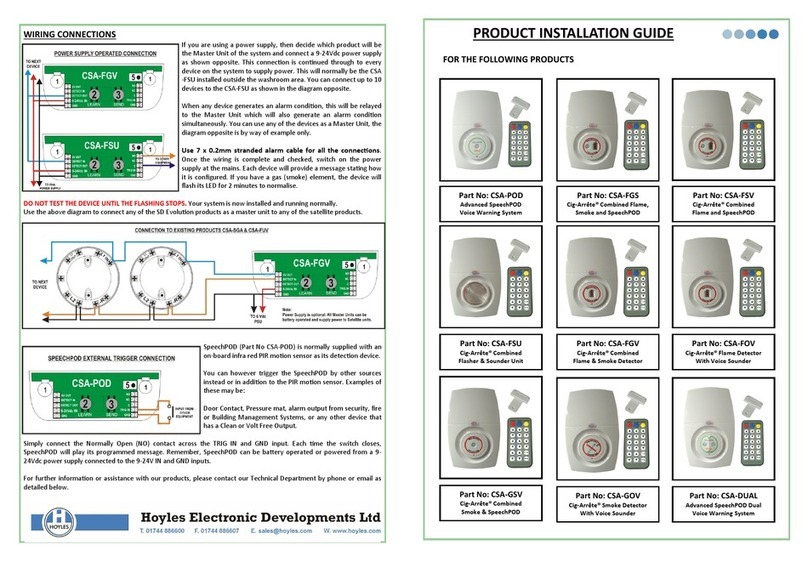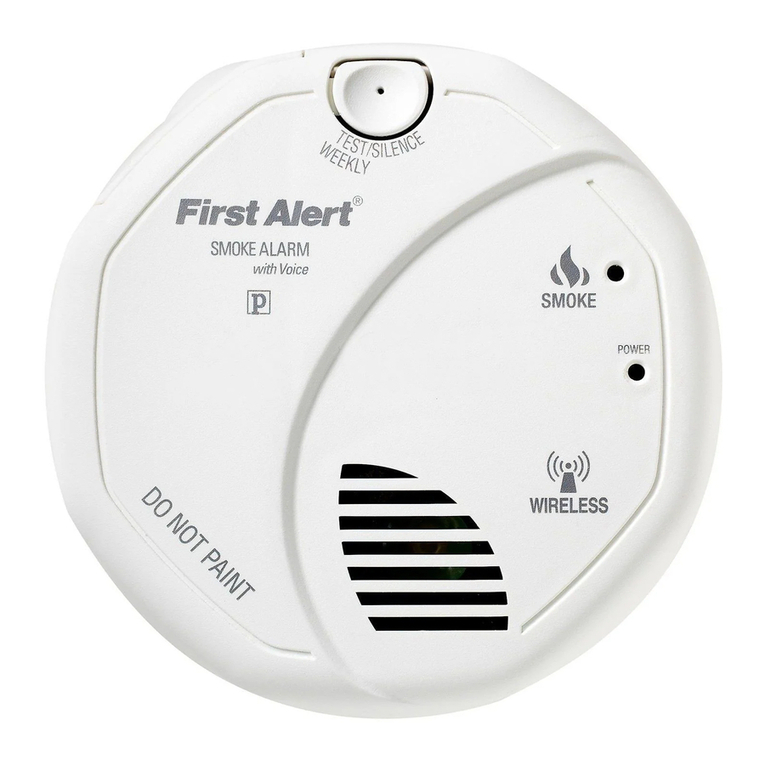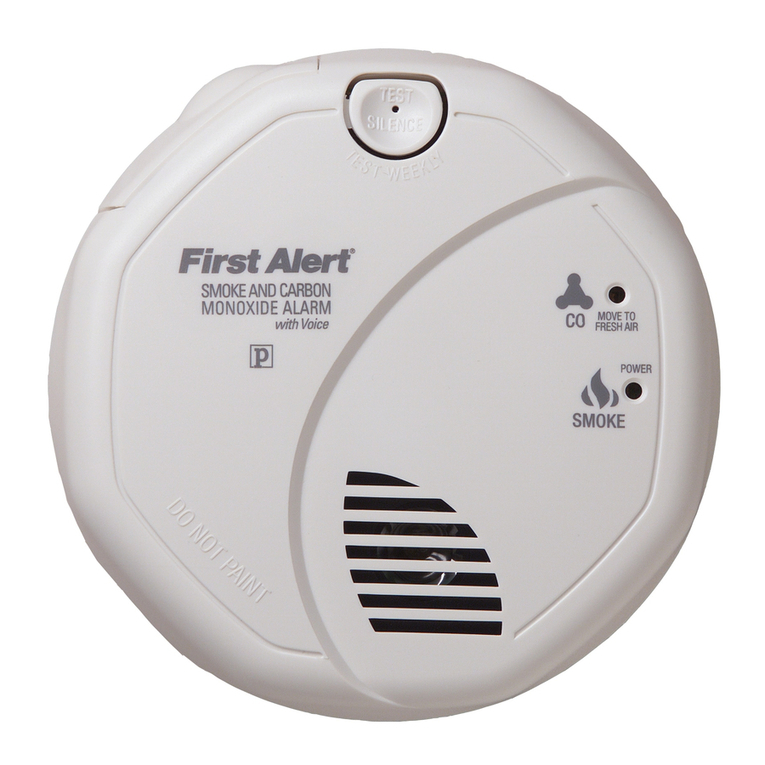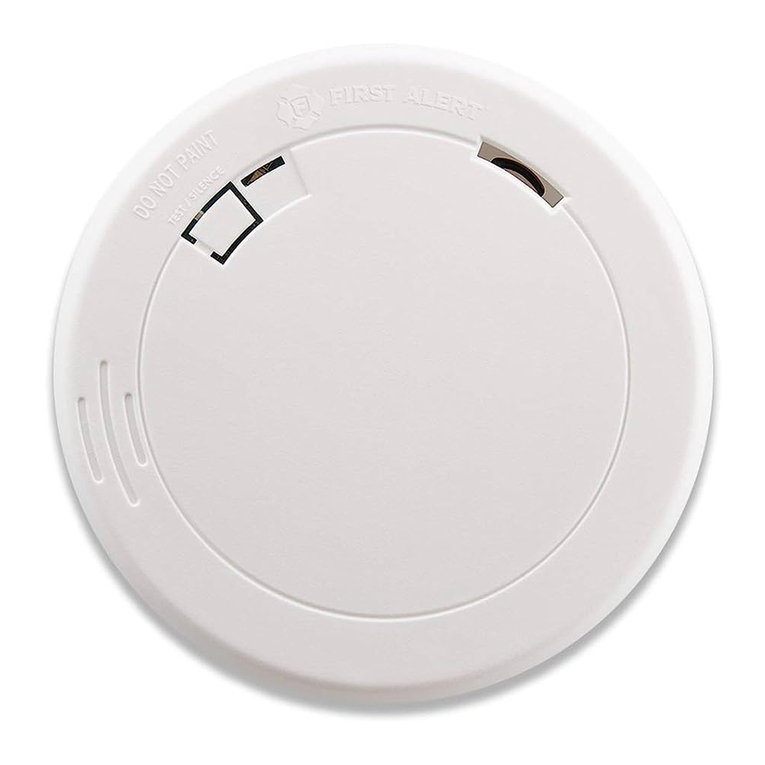
WEEKLY TESTING
NEVER use an open flame of any kind to test this unit. You might
accidentally damage or set fire to the unit or to your home. The
built-in test switch accurately tests the unit’s operation as required
by Underwriters Laboratories, Inc. (UL).
It is important to test this unit every week to make sure it is working
properly. Using the test button is the recommended way to test this
Smoke Alarm. Press and hold the test button on the cover of the unit
until the alarm sounds (the unit may continue to alarm for a few seconds
after you release the button). If it does not alarm, make sure the unit is
receiving power and test it again. If it still does not alarm, replace it
immediately. During testing you will hear a loud, repeating horn pattern:
3 beeps, pause, 3 beeps, pause.
HOW TO INSTALL THIS SMOKE ALARM
THE PARTS OF THIS SMOKE ALARM
FOLLOW THESE SIMPLE STEPS!
Tools you will need:
• Pencil • Drill with 3/16” (5 mm) drill bit
• Hammer • Standard Flathead screwdriver
1. Remove the mounting bracket from the Smoke Alarm base. Hold the
mounting bracket against the ceiling (or wall) and make a mark at
the center of each of the mounting slots with a pencil.
2. Put the unit where it won’t get covered with dust when you drill the
mounting holes.
3. Using a 3/16” (5 mm) drill bit, drill a hole through each pencil mark.
4. Insert the plastic screw anchors (in the plastic bag with screws) into
the holes. Tap the screw anchors gently with a hammer, if necessary,
until they are flush with the ceiling or wall.
5. Tighten the screws (provided) into the screw anchors.
2 3
6. Activate the battery. With the battery
compartment open, install the battery
so the terminals on the battery match
the terminals on the Smoke Alarm.
Match “+” to “+” and “-” to “-.” Push
the battery in until it snaps in securely
and cannot be shaken loose.
If the battery is not snapped in completely, the unit cannot receive
battery power. The Smoke Alarm may beep briefly when you install
the battery—this is normal.
7.
Position the base of the Smoke Alarm over the mounting bracket
and turn. The Alarm can be positioned over the bracket every 60°.
Turn the Smoke Alarm clockwise (right) until the unit is in place.
8. Test the Smoke Alarm. See “Weekly Testing.”
REGULAR MAINTENANCE
This unit has been designed to be as maintenance free as possible, but
there are a few simple things you must do to keep it working properly.
Use only the replacement batteries listed below. The unit may not
operate properly with other batteries. Never use rechargeable
batteries since they may not provide a constant charge.
• Test it at least once a week.
• Clean the Smoke Alarm at least once a month; gently vacuum the
outside of the Smoke Alarm using your household vacuum’s soft
brush attachment. A can of clean compressed air (sold at computer
or office supply stores) may also be used. Follow manufacturer
instructions for use. Test the Smoke Alarm. Never use water, cleaners
or solvents since they may damage the unit.
• If the Smoke Alarm becomes contaminated by excessive dirt, dust
and/or grime, and cannot be cleaned to avoid unwanted alarms,
replace the unit immediately.
• Relocate the unit if it sounds frequent unwanted alarms.
See “Locations to Avoid for Smoke Alarms” for details.
• When the battery becomes weak, the Smoke Alarm unit will “chirp”
about once a minute (the low battery warning). This low battery
warning should last for 7 days, but you should replace the battery
immediately to continue your protection.
Choosing a replacement battery:
Your Smoke Alarm requires one standard 9V battery. The following
batteries are acceptable as replacements: Duracell #MN1604, (Ultra)
#MX1604; Eveready (Energizer) #522. You may also use a Lithium
battery like the Ultralife U9VL-J-P for longer service life between battery
changes. These batteries are available at many local retail stores.
Continued...
The Parts of This Unit
1. Mounting Bracket
2. Mounting Slots and Screws
3. Locking Pins (break out of bracket)
4. Latch to Open Battery Compartment
5. Swing-Out Battery Compartment
To remove the mounting bracket
from the Smoke Alarm base, hold the
Smoke Alarm base firmly and twist the
mounting bracket counterclockwise.
1
2
3
2
5
4
3
IF THIS SMOKE ALARM SOUNDS
RESPONDING TO AN ALARM
During an alarm, you will hear a loud, repeating horn pattern:
3 beeps, pause, 3 beeps, pause.
• If the unit alarms and you are not testing the unit, it is warning
you of a potentially dangerous situation that requires your
immediate attention. NEVER ignore any alarm. Ignoring the
alarm may result in injury or death.
• Never remove the batteries from a battery operated Smoke Alarm
to stop an unwanted alarm (caused by cooking smoke, etc.).
Removing batteries disables the alarm so it cannot sense smoke,
and removes your protection. Instead open a window or fan the
smoke away from the unit. The alarm will reset automatically.
• If the unit alarms get everyone out of the house immediately.
+
–
OPTIONAL LOCKING FEATURES
The locking features are designed to discourage unauthorized removal of the battery or Alarm. It is not necessary to activate the locks in
single-family households where unauthorized battery or Alarm removal is not a concern.
These Smoke Alarms have two separate locking features: one to lock the battery compartment, and the other to lock the
Smoke Alarm to the mounting bracket. You can choose to use either feature independently, or use them both.
Tools you will need: • Needle-nose pliers or utility knife • Standard Flathead screwdriver.
Both locking features use locking pins, which are molded into the mounting bracket. Using needle nose pliers or a utility knife,
remove one or both pins from the mounting bracket, depending on how many locking features you want to use.
To permanently remove either lock, insert a flathead screwdriver between the locking pin and the lock, and pry the pin out of the lock.
Locking Pin
TO LOCK THE BATTERY COMPARTMENT
Do not lock the battery compartment until you have installed the
battery and tested the unit.
1. Push and hold test button until the alarm sounds:
3 beeps, pause, 3 beeps, pause.
If the unit does not alarm during testing,
DO NOT lock the battery compartment!
Install a new battery and test again. If the
Smoke Alarm still does not alarm, replace it
immediately.
2. Using needle-nose pliers or a
utility knife, detach one locking
pin from the mounting bracket.
3. Push the locking pin through
the hole near the battery
drawer on the back of the
Smoke Alarm.
TO UNLOCK THE BATTERY COMPARTMENT
1. Remove the Smoke Alarm from the mounting bracket. If the unit is
locked to the bracket, see the section “To Unlock the Mounting
Bracket.”
2. Insert a flathead screwdriver under the
head of the locking pin, and gently pry
it out of the battery compartment lock.
(If you plan to relock the battery
compartment, save the locking pin.)
3. To relock the battery compartment, close the battery door and
reinsert locking pin in lock.
4. Reattach the Smoke Alarm to the mounting bracket.
When replacing the battery, always test the Smoke Alarm before
relocking the battery compartment.
TO UNLOCK THE MOUNTING BRACKET
1. Insert a flathead screwdriver between the
mounting bracket pin and the mounting
bracket.
2. Pry the Smoke Alarm
away from the
bracket by turning
both the screwdriver
and the Smoke Alarm
counterclockwise
(left) at the same
time.
TO LOCK THE MOUNTING BRACKET
1. Using needle-nose pliers, detach one locking pin from mounting bracket.
2. Insert the locking pin into the lock located on the pivoting hinge of the
battery door.
3. When you attach the Smoke Alarm to the mounting bracket, the locking
pin’s head will fit into a notch on the bracket.
WHAT TO DO IN CASE OF FIRE
• Don’t panic; stay calm. Follow your family escape plan.
• Get out of the house as quickly as possible. Don’t stop to
get dressed or collect anything.
• Feel doors with the back of your hand before opening them.
If a door is cool, open it slowly. Don’t open a hot door. Keep doors
and windows closed, unless you must escape through them.
• Cover your nose and mouth with a cloth (preferably damp).
Take short, shallow breaths.
• Meet at your planned meeting place outside your home,
and do a head count to make sure everybody got out safely.
• Call the Fire Department as soon as possible from outside.
Give your address, then your name.
• Never go back inside a burning building for any reason.
• Contact your Fire Department for ideas on making your home safer.
Alarms have various limitations. See "Limitations of Smoke Alarms"
for details.
REGULAR MAINTENANCE, Continued
Actual battery service life depends on the Smoke Alarm and the
environment in which it is installed. All the batteries specified above
are acceptable replacement batteries for this unit. Regardless of the
manufacturer’s suggested battery life, you MUST replace the battery
immediately once the unit starts “chirping” (the “low battery warning”).
Alarm Base
1. Battery Compartment
2. Test button (CAT. NO. SA300)
2. Test/Silence button
(CAT. NO.’s SA303 and SA305)
This unit is designed to be mounted on
the ceiling, or on the wall if necessary.
DO NOT attach this Alarm to an electrical junction box.
Attachment to an electrical box may impair the Alarm’s operation.
Attach directly to wallboard or flat wall or ceiling surface.
